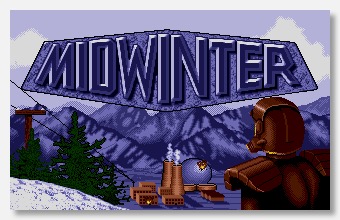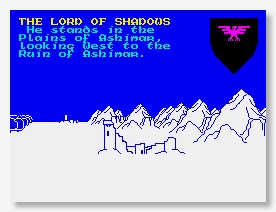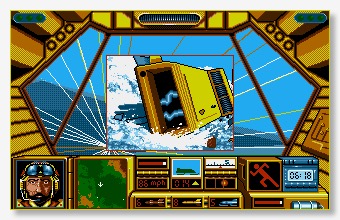9 - Midwinter
On the late Mike Singleton and the importance of Midwinter and The Lords of Midnight, his two great works. After switching from high school English teaching to professional game development in the 1980s, Mike quickly rose to the top of the industry. His games pushed the limits of what was possible, and he routinely crafted worlds that were way ahead of their time.
Here, based on archival research and old magazine interviews, I present part of his incredible story.

Support comes from my Patreon backers, with special credit going to my two $10+ backers Wade Tregaskis and Simon Moss. Thanks fellas!
Music and SFX credits:
- The 49th Street Galleria, Readers! Do You Read?, and Out of the Skies, Under the Earth by Chris Zabriskie
- Audio recordings from Midwinter
- And everything else is my own work.
(Partial) Transcript
Mike Singleton was a 27 year old high school English teacher in Cheshire, a county in the northwest of England, when he first came to computers. It was 1978, and he'd just received a Sinclair 32-step programmable calculator for his birthday. He soon finished writing his first program, a simple matchstick game, then moved onto a utility program to help his friend at a betting shop with the complicated equations used in a special set of 13 bets called "around the clock".
The pair had grander ambitions, so they shared the cost of a Texas Instruments calculator that could manage up to 200 steps per program. With that, they were able to design a calculating utility for 15 different types of bet. Then they thought, "Maybe we can write a program that will not only calculate the bets but also do all the office work in the betting shop as well."
They bought a Commodore PET — a Pet, as its users commonly called it — which was one of the earliest pre-assembled personal computers. Their best-laid plans proved a bust, however, when they discovered that data entry took too long for them to cope with the rush of punters heading to the counter to place their bets right before the start of a horse race.
So Mike messed around for a while, and he soon came up with a new betting game. It was a computer-run horse race called Computer Race, complete with animated horse graphics based on famous timelapse horse photographs. He intended the game for use on days of inclement weather — when there's no horse racing — so that punters could at least bet on a virtual race.
They sold a copy to a shop in Ireland, but couldn't publish it locally because it was deemed to be a borderline case for breaking Britain's betting laws, which outlawed entertainment and comfort within betting shops because they encourage people to gamble.
His programming adventures didn't end there. Mike next made another game on his Commodore PET — a hand-assembled effort written entirely in machine code that occupied what was then a staggering 12 kilobytes of memory. That game, Space Ace, was published commercially by Petsoft and at 300 copies sold managed to break the platform's sales records.
At around the same time, Petsoft was in talks with Sinclair to write software for the new ZX80 home computer, so in anticipation of that Mike started to learn the system.
When the deal fell through, Mike rang up inventor and entrepreneur Sir Clive Sinclair, who you can probably guess is the founder of Sinclair Research. Clive told him to send his games along. A while later, Mike got an invitation to Sinclair headquarters in Cambridge to look at the ZX80 successor, the ZX81 — a computer built for the masses.
Soon after, Mike used his time off over school holidays to write Games Pack 1 — a collection of six tiny games programmed in BASIC that went on to sell an incredible 90,000 copies.
From there his confidence and skill steadily improved. He quit teaching in 1982 to focus on game development full time. He stepped up to programming multiple machines — the Commodore VIC-20, the BBC Micro, and the ZX81's more powerful successor, the ZX Spectrum — and he made more games, all of them arcade-style action, and began to explore the limits of what was possible on the machines. One game, 3-Deep Space, even shipped with stereoscopic 3D glasses.
And while all this was going on, he ran a popular play-by-mail game called Star Lord — a grand strategy game set in space in which players could send in their moves and he'd mail back full-colour maps with their location and detailed status reports, all for just one-and-a-quarter pounds per turn.
Then came what many consider his magnum opus, The Lords of Midnight.
Mike started on the game after a meeting with his friend Terry Pratt, founding and recently-departed editor of Computer and Video Games Magazine, who had just taken up the top role at a new publisher called Beyond Software.
The Lords of Midnight was intended to be kind of like bestselling adventure game The Hobbit, except better. And it was. It was a strategic wargame encased in an adventure game, with a high-level objective to destroy the evil Witchking Doomdark — a Sauron figure if ever there was one — and save the Land of Midnight from perpetual winter.
The great triumph of Lords of Midnight was its technology. Mike once said that he preferred to begin his game projects with a programming technique, a technological hook that can define the possibility space as he moves into defining game mechanics and thematics. Before he had the concept for Lords of Midnight, he had a purely technological idea: how can a game's graphics be made more relevant to its action?
Here, with a mighty feat of programming magic, Mike Singleton made perhaps the first videogame place that seemed real. To fit his great Tolkien-esque universe into the Spectrum's mere 48 kilobytes of memory, he had devised a graphical trick called landscaping, which procedurally drew the game's vast world to the screen not from above but from a rudimentary first-person perspective. It presented panoramic views of the landscape set before the player — views that could be rotated around in any of eight compass directions — by checking where a player was on the map and which way they were facing and then plotting out the nearby landscape features in panorama view at a scale appropriate to your distance from them.

What this meant in practice was simple: In Lords of Midnight, if you could see something, you could go there.
At a time when other games would boast of having dozens of locations, Lords of Midnight crammed in 4,000 — with 32,000 separate corresponding views. And where Melbourne House's remarkable computer adventure game adaptation of The Hobbit had needed a minute or more to draw its purely decorative graphics, Lords of Midnight could put its equally impressive, very much functional visuals on the screen in mere seconds.
And the technology was not just about expansive maps and panoramic views; that same layering that made it possible to walk ever deeper and farther into a billboard also enabled a freedom to make your own Tolkien-esque adventure. There were four Lords that could be recruited and moved independently from each other, epic quests to complete, caves to explore, enchanted weapons and items to discover, armies to fight, and two different approaches to victory: either a military conquest led by one Lord, Luxor, the owner of the Moon Ring; or a stealthy approach via completing quests with another Lord, Morkin, whose ability to resist the psychological power of Doomdark's warriors' Ice Fear meant he could find and destroy Doomdark's Ice Crown at the Tower of Doom in Ushgarak.
(Which probably all sounds like gobbledygook to you if you're unfamiliar with Tolkien's stories, but is a pretty heavy-handed reference to the story of The Lord of the Rings, except now with the option for you to pick your own path to victory.)
He quickly followed it up with a sequel that managed to squeeze even more people and places and things to do into the Spectrum's paltry 48K of RAM, at the expense of some of The Lords of Midnight's character as a hand-crafted world, then made or contributed to several more games over the next few years — including a side-scrolling strategy game called Dark Sceptre and an early attempt at real-time tactics with 1988 title War in Middle Earth, which was not just inspired by Tolkien's world but also directly set within it.
But I want to focus here on the game he made after that flurry of projects. A game that pushed 16-bit computer technology and game design more broadly in similar ways to what The Lords of Midnight had done with 8-bit machines.
I'm talking about Midwinter, a 1989 Atari ST and Amiga game that defied classification. It was partly a stealth game, but also a strategy game. And an open-world game and first-person shooter, before either of those terms existed. And action, and RPG, and adventure. It had elements of pretty much everything. So let's not bother trying to describe it in terms of genre.
Midwinter was a game about the end of the world. A game set in a future where most creatures — human or otherwise — have been wiped out as a result of a meteorite impact 59 years before the story begins. This is a world ravaged by war, famine, extreme climate change, massive social and economic upheaval, and all the deadly bickering among humans that you might expect these forces to intensify.
Unlike with The Lords of Midnight, which he'd made singlehandedly, Mike developed Midwinter with help from his friends at Maelstrom Games, a company he'd co-founded when he was unable to find a publisher for his 1987 game Dark Sceptre — which had been released to critical acclaim and introduced a four-channel sound technique to the audio-poor Spectrum.
Midwinter's origins lay, as ever for a Mike Singleton game, in technology. With the 8-bit home computer era fading into the background and much more powerful 16-bit machines in full swing, they'd been exploring the capabilities of the Atari ST. One day in 1988 they completed a tech demo that made a huge mountain out of 96 flat-shaded polygonal faces and allowed you to move smoothly around this mountain.
Abstracted away, what the feat meant was that they could have large, solid 3D vector-drawn objects on the screen and they scroll smoothly and quickly past and around them.
From there, Mike outlined a basic design. He wanted the game to incorporate elements of chess — to have many characters moving around the world at the same time in the same way that you have multiple chess pieces in play both simultaneously and independently. The theme reportedly came from an internal push at publisher MicroProse to make its operations more environmentally friendly. They'd done research into what the world might be like in 50 years and found the "exciting" prospect of a new Ice Age.

Amiga Format and Zzap were no less enthusiastic in their praise, with the review in the latter calling its graphics "breathtaking" and its atmospheric stereo sound "extremely good", concluding that it's "a superlative, immense program that is every bit as good as you'd expect from Mike Singleton." Amiga Power went even further with their conclusion, which stated "Never has so much effort been spent on creating a new environment. It's not a game, it's a virtual reality. Be there."
***
Midwinter offered 32 playable characters, each of whom had their own personality, talents, and loyalties that you had to deal with, and who could be directed to collaborate or to work alone. Their relationships were complex, mired in jealousy and hatred and admiration and all the usual things that blight a community.
In a clever design conceit, Mike broke the game into turns that lasted for two hours — so you would control one character for two hours of game time, then time would rewind and you'd control the next character for the same two-hour period, with time only moving beyond those first two hours once every character had had their turn.
They had several modes of transport available to them, along with a full suite of possibilities. You might choose to pick off the enemy leaders with sniper fire or take down vehicles with missiles and grenades, or perhaps sneak around them to focus on a bigger target. There were locals to call on for passive resistance, too, some skilled in useful professions and others merely ready to do their bit.
And if The Lords of Midnight had felt huge with its 4,000 locations and 32,000 static views, then Midwinter was positive enormous at 160,000 square miles of explorable terrain. Yet that size was secondary to the weight of its story — to that sorry plight of the people of Midwinter Isle and their fallible, all-too-human hero, ice-locked and struggling to survive not just the brutality of this frozen wasteland but also that of their far better-equipped and better-organised would-be conquerors.
This was the stuff of the future, the stuff of now. Yet Mike Singleton had made it happen 30 years ago.
(For more you'll have to either just listen to the episode or sign up as a supporter on Patreon — everyone who pledges $3 or more a month gets access to full episode transcripts [amongst other things].)
The Life & Times of Video Games on the Web and social media
- Website: lifeandtimes.games
- Twitter: @LifeandTimesVG
- Instagram: @lifeandtimesvg
- YouTube: lifeandtimes.games/youtube
You can make a donation to help cover running costs and allow me to rely less on freelance income via
- Patreon: lifeandtimes.games/patreon
- or PayPal: paypal.me/mossrc
Can't afford to give me money? Consider listening via the RadioPublic app for Android or iOS. It's free. And if you enable analytics then I get paid a couple of cents each time you listen to my show. Head to RadioPublic.com for more info.


